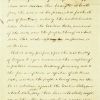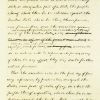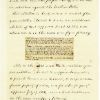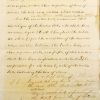On September 22, 1862, following the Union victory at Antietam, President Lincoln issued this document, ordering that in 100 days the federal government would deem all slaves free in those states still rebelling against the Union. The Preliminary Emancipation Proclamation is the only surviving Proclamation document in Lincoln’s own hand. Lincoln probably glued in sections of the Congressional Confiscation Act to save time—the fingerprint visible on the first page of the document is probably his own.
In 1864, Lincoln donated the document to the U.S. Sanitary Commission, which raffled it off at the Albany Relief Bazaar to help raise money for the Union war effort. Abolitionist Gerrit Smith won the raffle after buying 1,000 tickets at $1 apiece. Smith then sold the document to the New York State Legislature, with funds going to the Sanitary Commission. The legislature, in turn, deposited the document in the New York State Library, where it remains today.

Photograph by Alexander Gardner, October 3, 1862






